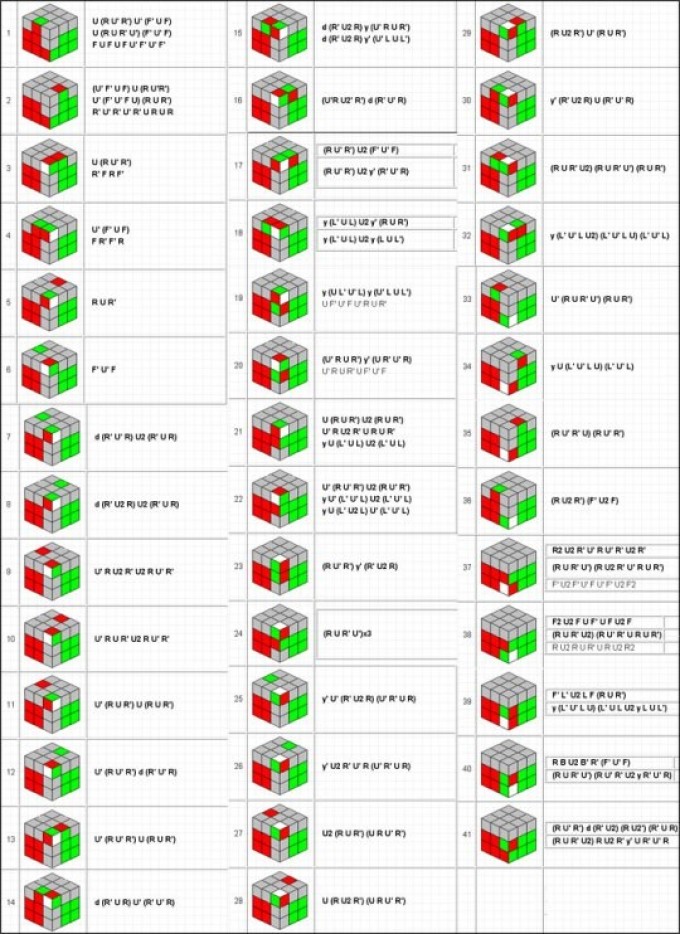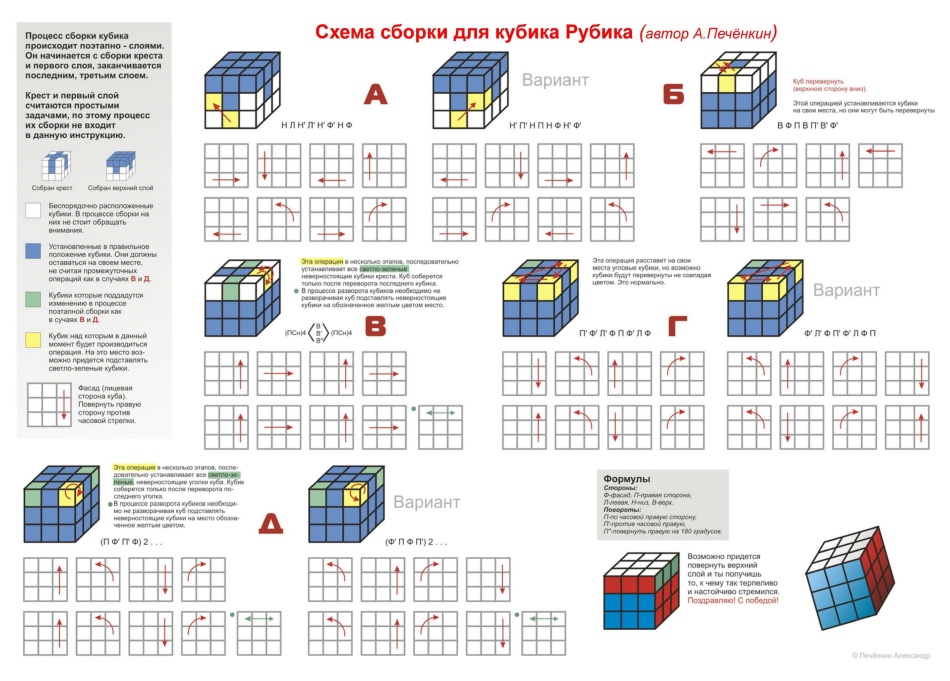The famous puzzle, which is several color sectors, united in one cube, appeared in 1974. The Hungarian sculptor and teacher decided to create a textbook to explain group theory to students. To date, this toy is considered the best sold all over the world.
Content
But, success to this puzzle came only when German entrepreneur Tibor Laksi drew attention to it. He, together with the inventor of the Games Tom Cremer, established not only the release of cubes, but also organized the advancement of this puzzle to the masses. It is thanks to them that competitions in the high -speed assembly of Rubik cubes appeared.
By the way, people who are engaged in such an assembly of this puzzle are called speedkubers (“Speed” - speed). It is not difficult to guess that the high -speed assembly of the “magic” cube is called speed -jinging.
The structure of the cube of the chip and the name of the rotations
In order to learn how to collect this puzzle, you need to understand its structure and find out the correct name of certain actions with it. The latter is important if you are going to find the instructions for assembling a cube on the Internet. Yes, and in our article we will call all the action with this puzzle, according to established expressions.
The standard rubber cube consists of three sides. Each of which consists of three parts. Today there are also 5x5x5 cubes. The classic cube has 12 ribs and 8 corners. It is painted in 6 colors. Inside this puzzle is a cross, around which the movements of the sides are moving.

At the end of the cross, a square with one of six colors is rigidly located. Around it, you need to collect the rest of the squares of the same color. Moreover, the puzzle is considered collected if on all six sides of the cube its color is collected.
Important: in the original puzzle, the yellow color is always opposite white, orange - red, and green - blue. And if you disassemble the puzzle, and then fold it incorrectly, then this can lead to the fact that it can never be collected.
In addition to the centers of the cube, the constant components of this puzzle are angles. Each of the eight corners consists of three colors. And no matter how you change the position of the colors in this puzzle, the composition of the colors of the angles in it will not change.
IMPORTANT: The Rubika Cube is collected by placing corner and medium sectors in accordance with the colors of the central sectors.

Now, when we realized, the design of this puzzle is time to move to the names of the parties and rotations and their designation in specialized literature.

In the process of assembling the Rubik cube, it may require not only the movement of the parties, but also the change in the position of this object in space. Experts call these movements interceptions. This is schematically displayed as follows:

Important: if in the algorithm of the assembly of the cube you find, only the letter is indicated, then we change the position of the side clockwise. If after the letter the sign of the apostrophe “’ ”is indicated, then we rotate the side counterclockwise. If after the letter the number “2” is indicated, then this means that the side needs to rotate twice. For example, D2 ′ - we rotate the lower side counterclockwise twice.
Simple and easy assembly method: instructions for children and beginners
The most detailed assembly instructions for beginners are as follows:
- At the first stage of the assembly of this popular puzzle, we start with the right cross. That is, with the fact that on each side of the cube the color of ribs and centers will be the same.
- To do this, we find the white center and white ribs and collect crosses according to the scheme below:

- After the above actions, we must get a cross. Of course, the first time the cross will not be correct and you need to transform the resulting option a little. With the right performance, it will be quite simply to change the ribs among themselves.
- This algorithm is called "Pyt-PAF" and is shown in the diagram below:

- We proceed to the next step of the assembly of the puzzle. We find the white corner on the lower layer and put a red corner over it. This can be done in different ways, depending on the position of the red and white angles. We use the PIF-PAFA method described above.

- As a result, we should be the following:

- We begin to collect the second layer. To do this, we find four ribs without yellow and place them between the centers of the second layer. Then we twist the cube until the color of the center coincides with the color of the element of the edge.
- As with the assembly of the previous layer, you may need one of several options to achieve this goal:

- After we successfully completed the previous step, we move on to the assembly of the yellow cross. Sometimes, he is “gathering” himself. But this happens very rarely. Most often, the cube at this stage has three options for the location of the flowers:

So, the yellow cross is collected. Further action when solving this puzzle comes down to seven options. Below is shown each of them:

In the next step, we need to collect the corners of the upper layer. Take one of the corners and put it in place using the U, U ’and U2 movements. In this case, you need to take into account. So that the colors of the corner are identical colors on the lower layers. When using this step, keep the cube white to yourself.

- The final stage of assembly of the cube is the assembly of the ribs of the upper layer. If you did all the above correctly, then four situations may arise. They solve very simply:

The fastest way. Jessica Friedrich method
This puzzle assembly method was developed by Jessica Frederick in 1981. It conceptually does not differ from most of the known methods. But, it emphasizes precisely on the assembly speed. Due to this, the number of assembly stages decreased from seven to four. To master this method, you need to master the "total" 119 algorithms.
Important: this technique is not suitable for beginners. Its study should be done when your cube assembly speed will become less than 2 minutes.
1. At the first stage, you need to collect a cross with side faces. In specialized literature, this stage is called "Cross" (from the English Cross - Cross).
2. At the second stage, you need to collect two layers of puzzle at once. He is called "F2L" (from the English. First 2 Layers - the first two layers). The following algorithms may be required to achieve the result:

3. Now you need to collect the top layer completely. You should not pay attention to the side sides. The name of the stage is OLL (from the English. Orientation of the Last Layer - orientation of the last layer). For assembly, you need to learn 57 algorithms:

4. The final stage of assembly of the cube. PLL (from the English. Permutation of the Last Layer - the arrangement of elements of the last layer in places). Its assembly can be carried out using the following algorithms:

Assembly scheme of a 3x3 chubby cube in 15 moves
Since 1982, when the competition for the high -speed assembly of the Rubik cube appeared, many lovers of this puzzle began to develop algorithms that would help to properly arrange the cube sector with a minimum of moves. Today, the minimum number of moves in this puzzle is called "The Algorithm of God" And amounts to 20 moves.
Therefore, for 15 moves you can not collect a cube of the chip. Moreover, a few years ago, an 18-year algorithm for assembling this puzzle was developed. But, it can not be used from all the provisions of the cube, therefore it was rejected as the fastest.
In 2010, scientists from Google created a program with which they calculated the fastest algorithm for assembling the Rubik cube. He confirmed that the minimum number of steps is 20. Later, from the details of the popular designer, a LEGO MINDSTORM EV3 robot was created, which is capable of collecting a chub of chubby from any position in 3.253 seconds. He uses in his "work" 20 walking "The Algorithm of God". And if someone tells you about the fact that there is a 15-step cube assembly scheme, do not believe him. Even Google's capacities are “missing” to find it.









Not so clear, but thanks anyway
Several video lessons are revised! I give my preference to this video! Thank you very much for the lesson, I first gathered the Rubik's cube))
Thank you, Ivan !!)))) I did it, I can’t believe it !!!!)))
The video is excellent, you just need to think a little more.
To the one who wrote a negative review:-If the thought does not think, then you do not need to think that someone can make her think!
Everything is clearly and understandable! The video is great! For 2 hours of training, I learned to collect without prompts!
The author is reverence :))) gathered !!!!!!!! The schemes are literal. Of course, all options are extremely difficult and almost not possible to show that may turn out at the assembly stage, but the selection of these algorithms can be at the desired combination.
I did it super, but I tried 6 hours. I did not even believe that it can be collected! Thank you!
Thank you so much for the vidosik !!! I managed! I set myself the goal of gathering it before DR, but without much torment I coped in 2 hours! Now it remains to bring to automatism! Thank you!
The formula with the arrangement of the angles of the last layer does not always work. It's a pity, I already thought that this is an optimal algorithm in the ratio of the number of formulas and turns
Respect to the author of the video. How much I reviewed the video before, I did not understand anything, but here everything is clear and accessible. Bravo!!!!!!!!!!
The formula “no eye on the right” often does not work if the location of the “eye is not” is fine from the example, and this happens quite often after all the yellow are raised to the top
A couple of years ago I found an algorithm of God for a dice of Rubik and wrote a program that implements it. If anyone is interested, I can send a description of the algorithm and share the program. The description is designed for high school students. The program is performed in Win32, Win64.
i used to collect a cube-cutter in 10 days and right now I collect in 10 minutes bow bow#cool
The formula “no eye on the right” does not always work! I collected a chubik twice according to this scheme, and for the third time I got stuck in a step “no eye on the right”, twisted for a long time, I thought I was doing something wrong, I decided to start it again and again reached the assembly of the corners at this step. The instructions say “Take one of the corners and put it in place ...”, but if it turned out to be correctly standing for 2 instead of 1, then this scheme simply changes the correct and incorrect corners in places, i.e. How many do not turn the collected angles 2 remain, and 4 does not work. Will you advise something except the video?
Really, accessible and understandable !!!!
Cool site! Not that others: I sat on one not very good site, and I have not learned anything there in a month! And then he came in and understood everything in an hour! Thank you!
5 stars of four!)
12 hours I was tormented until I came across this article. Thank you. All clear!!!